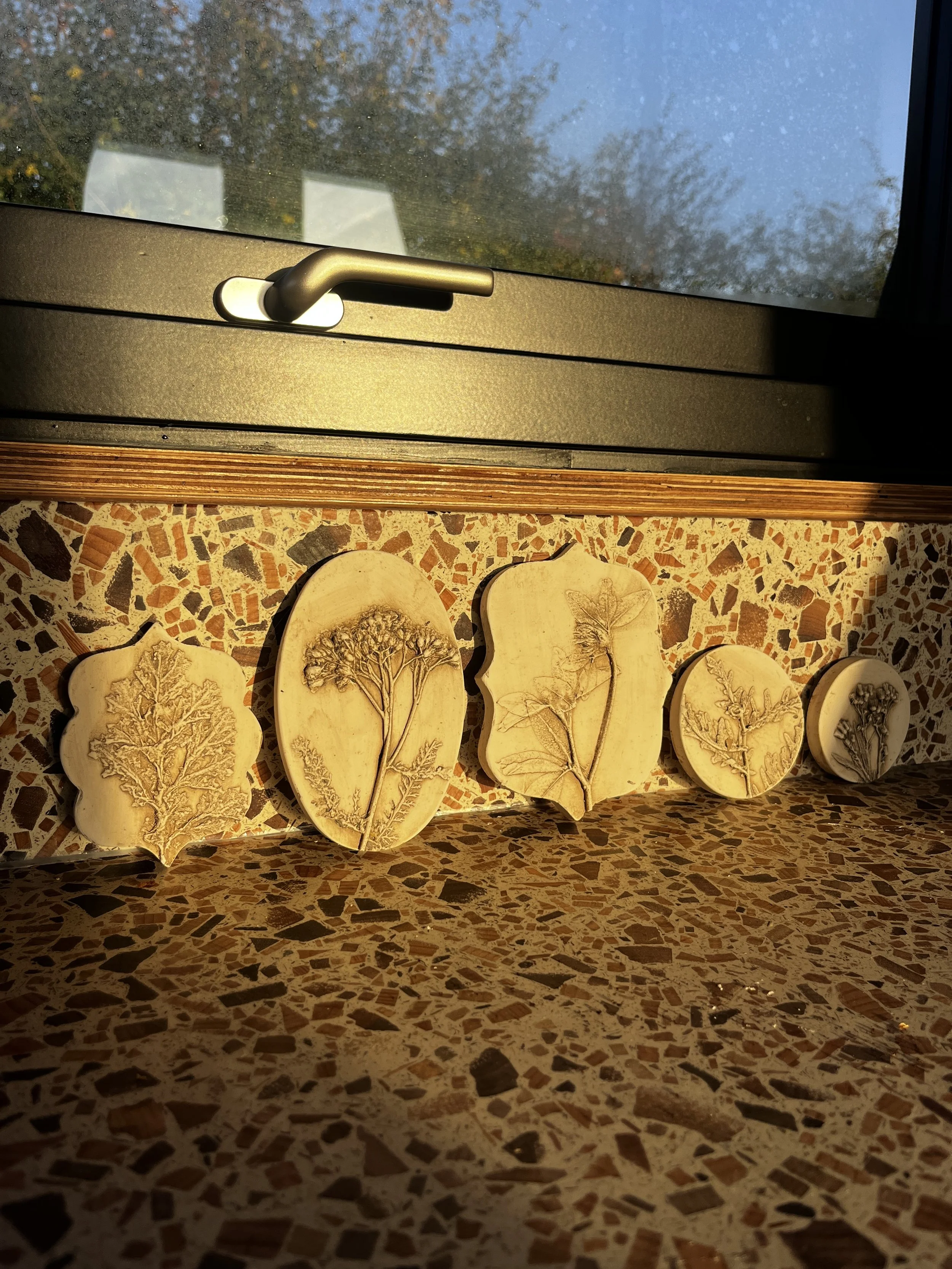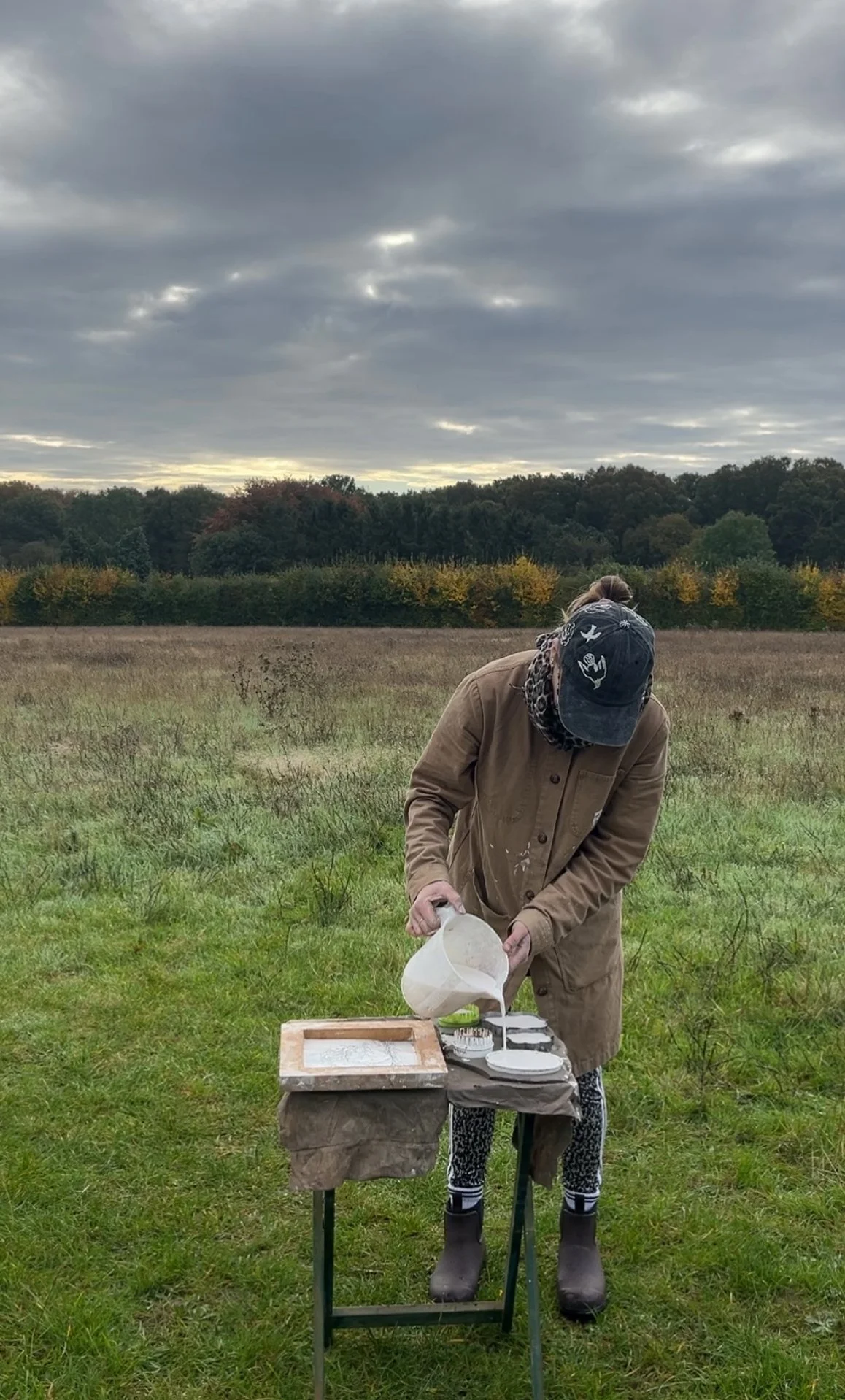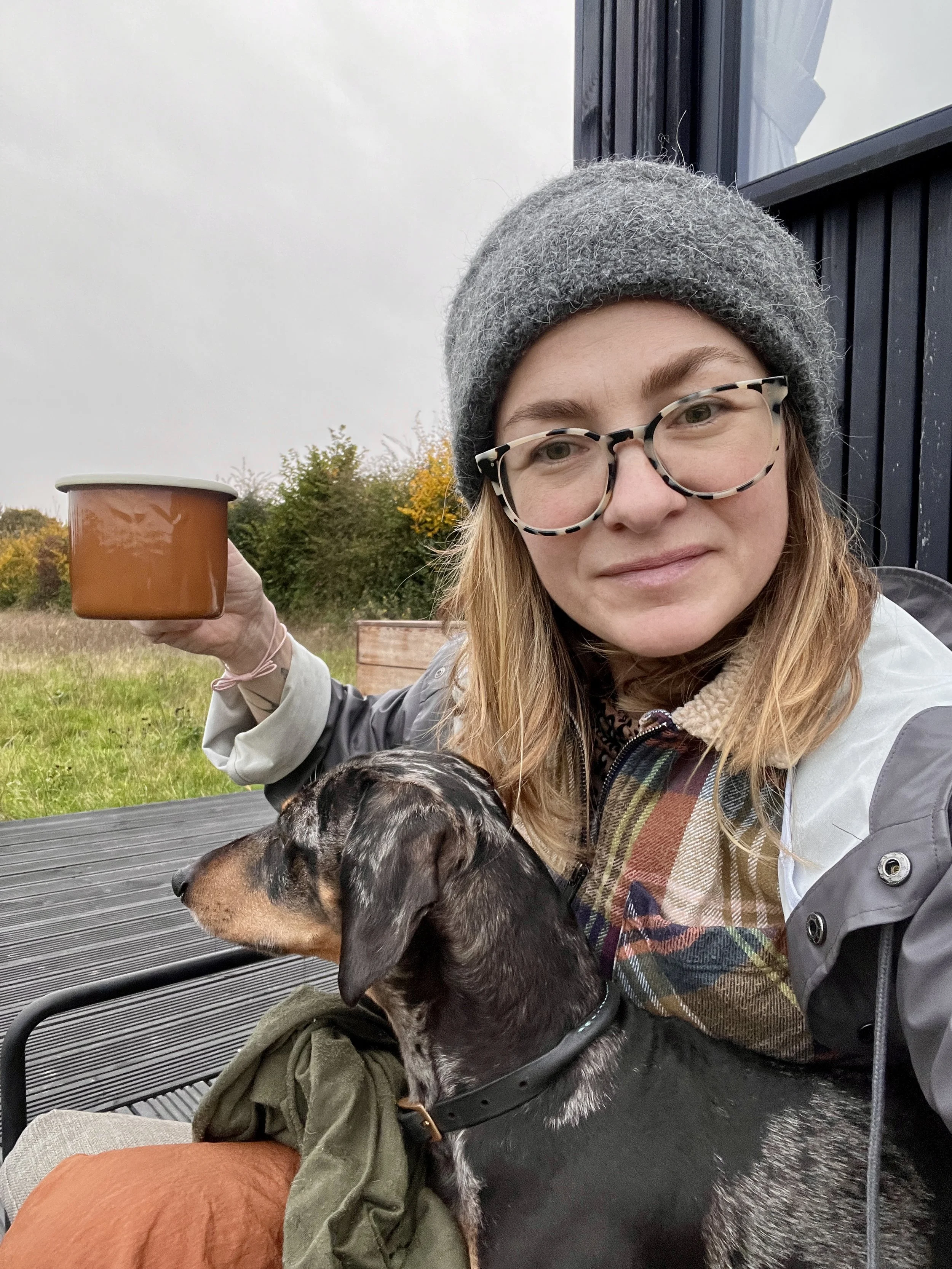Katy Eccles, Part 3 of our creative series. Making art from nature.
This week, we hear from Katy Eccles as part of our Creative Series: Re Creates. We invited Katy to come and stay in our cabin in Hertfordshire and to create some art from flowers and weeds found in the meadow. She documented her process and talks about how she became inspired to slow down and make art.
Getting to know Katy
Both of my parents are architects, so I am very fortunate to have lived in beautiful homes that they built themselves. During the first part of my life, we lived in a converted stable right on the coast in a charming seaside town called Elie. You could open the garden gate and be right on the coastal path, which has definitely given me a lifelong love of the sea and coastal living.
We then moved to a farmstead further inland, which my parents slowly converted. It was surrounded by farmland and fields, so my childhood was largely spent outdoors, in what was a wonderfully innocent and carefree time. My mum is a wealth of botanical knowledge and incredibly green-fingered. She transformed the concrete cattle shed and the surrounding farmland into a stunning garden and woodland.
It was my mum who first started casting. She had learned the technique during a weekend workshop and wanted to cast her garden through the seasons for her own home. At the time, I was working in Edinburgh after returning from living in Australia, and I was really taken with her botanical casting. After leaving my full-time job in the lifestyle industry to pursue my first creative business (bespoke hand embroidery), I asked if she would teach me to cast, so I could add another skill to my creative repertoire. As an artist, it's always a hustle, and the more skills you can build, the easier it is to make a living.
We worked alongside each other for a season, but mum decided she would rather spend her time gardening than growing a new business (she has had many side hustles in her time). So, I took full control of Imprint in 2020 and haven’t looked back since.
Has it been tricky trying to perfect the art of casting?
Yes it has! There have been many failures and experiments gone awry but I learn much better by doing rather than reading or researching so I just tend to crack on and find my own techniques. I studied Art History at university so I don’t have a fine art or ceramic degree, so it has been a slow and steady process over the last few years of teaching myself how to adapt my casting technique so I can now make large, statement casts which was my goal when I started. Mum taught me the basics of how to make a very small piece and I have then spent many hours watching youtube tutorials, educating myself about the properties of plaster and clay, experimenting in the studio and crafting my own process. But I still make mistakes and I am very much still learning. At the moment I am trying to perfect creating 3D objects using my casts so this is a whole new technical challenge but I'm really enjoying the process.
What does the process of casting make you feel?
I’m generally a fast-moving, quick-thinking, and easily over-stimulated person, but I find I can truly slow down and relax the moment I step into my studio. The process is so delicate and cannot be rushed; the more care and time you invest, the better the impression you’ll get from the flowers, and the finer the cast will be. I get completely lost in the creative process and it often acts as a form of meditation for me. I feel incredibly lucky to call this my job and to spend my days crafting away in my plastery den.
Do you think that you ‘live slowly’?
Living slowly isn’t always easy in the fast-paced world we live in but I do try to carve out pockets of the day where I can disconnect and take a moment to slow down. I am lucky that I get to spend plenty of time outside and in nature as part of my job so I feel connected to the seasons and the natural world. Pinto and I are often found on the paths around Arthur’s Seat and the Crags, and I feel incredibly lucky to have that on my doorstep here in Edinburgh. We also regularly escape to the Pentlands or the beaches in East Lothian on weekends for a walk and a refreshing sea swim. Each day starts with a coffee in bed with my husband, reading my book for at least half an hour to clear my mind before the day begins, and I truly treasure these quiet moments. However, I think living slowly is becoming increasingly difficult in our overstimulated world, especially when running a small business. It’s all too easy to reach for your phone to complete that last task, send that final email, or respond to that Instagram comment.
What does living slowly mean to you?
To me, living slowly means taking the time to connect with the small moments in your day that bring you a sense of peace or connection. When I feel frazzled and overwhelmed, I try to take a time out—grab a flask of tea and head down to the beach for a swim, or take Pinto up to Arthur’s Seat to sit, listen, and watch, rather than do. It’s about gaining perspective and stillness within an otherwise fast-paced life.
How do you like to connect to your creativity?
Running a creative business can make it hard to fully connect with your creativity, as it often gets tangled up in admin, to-do lists, and work-related thoughts. While I do love my studio and find peace in that space, I usually still have other life admin running through my mind—like remembering to pick up a parcel from the framers or grabbing food for dinner. That’s why I’ve found that going on casting adventures and staying in beautiful places, like Re Cabins, where my sole focus is on slowing down, engaging with the landscape, and creating site-specific casts that celebrate the season, has been so valuable. These trips have allowed me to reconnect with my creativity in an intense, focused way, and I’ve felt truly enlivened by these experiences.
When you feel creatively blocked, what helps?
I’m incredibly lucky that my best friend, Hatti Pattisson, is also a highly acclaimed painter. We talk almost every day, supporting each other through the highs and lows of the self-employed artist life. We rely on each other to navigate daily challenges, share our excitement or nervousness about new projects, work through creative blocks, and offer reassurance during general wobbles. I truly couldn’t do it without Hatti. I also find that a weekend getaway with my husband and a change of scenery is incredibly inspiring, so we make sure to make time for those. And a visit to one of Edinburgh’s many amazing galleries, to sit among the incredible work of other artists, is always a great way to gain inspiration and perspective.
Do you have a favourite flower or plant to cast? Why?
Oh that’s a tricky one, as I probably have more than one favourite and it does tend to change depending on what season we are in. I have always been a huge lover of snowdrops as they herald the start of spring and lighter days, but they also cast beautifully so they are probably my top flower pick at the moment.
How does being in nature affect your mood and your wellbeing?
It’s key to my happiness, and I’m truly never happier than when I’m out for a walk in a wild, remote place with Dave and Pinto. Growing up in the countryside and spending so much time outdoors means I really need to be outside at least once a day to feel grounded, and a walk always lifts my mood. Living in a city can be a bit tricky for me, but Edinburgh is amazing because you can reach pockets of wilderness right from your doorstep. We’re currently planning a house build in Fife and will be relocating to the countryside, and I truly can’t wait.
Katy, casting at Reconnect.
Can you talk us through the process of the piece that you made for Re Cabins?
My stay at Re Cabins was part of a larger project where I’m traveling around the UK, staying in various locations, and creating botanical intaglios (miniature casts) from the seasonal foliage nearby. In the 18th century, young aristocratic men collected small plaster intaglios on their European travels as keepsakes, often mounted in cases or books to showcase their wealth and education. My aim is to embark on my own Grand Tour, while also reclaiming a tradition largely dominated by men.
Each intaglio I create reflects the landscape around the cabins, capturing a moment in the seasonal life of Britain’s flora. With climate change threatening our environment, it’s crucial to document and preserve the indigenous flowers and foliage. In addition to the intaglios, I also create a larger piece for each place where I stay, and the beautiful meadow at Re Cabins was the perfect setting for my work.
Though it was late in the season, there was still an abundance of red clover, ox-eye daisies, ragwort, yarrow, and tansy in bloom. After enjoying a morning coffee in the sunshine, I ventured out to select the flowers for the cabin cast. I pressed the fresh flowers into clay, carefully removed them, and poured plaster into the impressions they left behind. I let the plaster dry by the fire, revealing the cast the next day. After cleaning the surface, I added a hanging hole so it could be displayed in the cabin, overlooking the meadow where it was created
Did the cabin feel like a creative escape for you?
Absolutely, as soon as I stepped in the cabin I felt my shoulders drop and my creative energy stir. It’s such a quiet, peaceful and serene place and being able to step outside with a cup of tea in hand to stroll through the meadow and select the botanicals I wanted to preserve was perfect. Unwinding in the outdoor onsen under a starry sky was sublime too and the way all days should end.
Do you have any other creative hobbies?
I have a terrible tendency to want to try ALL the crafts. As mentioned previously, I used to run a hand embroidery business, so most evenings you’ll still find me stitching something. I’m always upcycling jackets and caps by adding little embroidered designs, so my hands are constantly busy. Recently, I’ve tried knitting, but it turns out I have very little natural talent for it—haha! However, I’m determined to stick with it and perfect the craft, as I have visions of knitting cardigans and hats in my future.
What does pursuing creative pursuits mean to you?
Creativity takes so many different forms, and I am constantly inspired by people who can sit down and write a book, compose a song, or create a painting from a blank canvas. Following a creative path isn’t easy—it comes with self-doubt, imposter syndrome, and financial challenges. But it’s all worth it for that moment when an idea or vision that’s been bubbling away in your mind finally comes to life. Belief in yourself and a love for your craft are essential to pursuing a creative path, but I definitely wouldn’t, or couldn’t, live without the energy that comes with a new idea, a fresh artistic connection, and the opportunities that arise when you follow your heart rather than your head.
What does 2025 look like for you? Will you be hustling, resting, experimenting, flexing?
Last year, we traveled quite a bit and had some incredible trips, so this year we're keeping things quieter on that front. As mentioned, we're heading into a house build and will be packing up, selling, and moving at some point this year. I'm trying to carve out time for everything, but I know it’s going to be a busy year. I have a few exhibitions planned, along with a show-stopping commission in the works, so I’m doing my best not to get overwhelmed and just take it week by week. I also have a few wonderful cabin exchanges booked, so I can’t wait to head off to different corners of the UK with my pop-up studio to create, explore, and slow down.
Katy Eccles, Q&A with Monica Innes - April 2025







